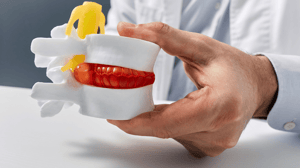
CRMA™ Reports For MRI Gap Analysis & Disc Herniations

CRMA™ report with MRI Gap Analysis Gives a More Complete Spinal Injury Read
Disc herniations without CRMA™ report findings can be considered to be pre-existing. MRI alone does not give the patient a complete spinal injury analysis.
Enter the CRMA™ report– a game-changing MRI gap analysis innovation that addresses the shortcomings of MRI while providing a comprehensive view of spinal health.
Problem: MRI's Limited Insight
Solution: CRMA™ Report's Comprehensive Approach
Problem: MRI's Limited Insight
Solution: CRMA™ Report's Comprehensive Approach
Problem: Incomplete Evidence
Solution: CRMA™ Reports Fill the Evidence Gap
Problem: Incomplete Evidence
Disc Herniations with MRI alone are a pre-existing condition unless ruled otherwise as there is not a smart bomb of energy that just hits the disc in say an automobile collision. If the disc is injured as a new injury from a current collision or some other force acting on the spine, there should also be non-disc ligament damage as without it, it is highly suspect that the disc herniation was already there and not from the accident.
Solution: CRMA™ Reports Fill the Evidence Gap
CRMA™ reports act as an MRI gap analysis tool that helps you to pick up the other non-disc ligament damage that would be consistent with what one should clinically find if the accident caused a new disc herniation.
Example: If your index finger was hit with a hammer and caused a stress fracture to the bone, it could be considered to be caused by something else if, for instance, the significant skin damage that would be consistent with this injury was not also documented. It would be hard to prove that the fracture was caused by the blow with no resulting skin damage present.
Problem: Suboptimal Treatment Outcomes
Solution: CRMA™ Reports Offer Comprehensive Insights
Problem: Suboptimal Treatment Outcomes
Research tells us the early MRI leads to worsening treatment outcomes and higher patient disability rates with the care that they receive. This is not because MRI is faulty, it just means that the MRI alone does not give a complete enough spinal injury analysis, and the patient is sent through inappropriate care paths that would have other wise be contraindicated if the full spinal injury picture was known.
Solution: CRMA™ Reports Offer Comprehensive Insights
CRMA™ reports provide an assessment that cannot be obtained with a non-weight bearing MRI. There are 220 spinal ligaments, only 23 of which are discs, therefore MRI assesses only about 10% of the actual spinal ligament structure. The other 197 non-disco ligamentous structures cause excessive spinal motion when damaged and that is what the CRMA™ reports pick up.
Problem: Missing the Source of Symptoms
Solution: CRMA™ Reports Reveal the True Cause
Problem: Missing the Source of Symptoms
Solution: CRMA™ Reports Reveal the True Cause
Problem: Incomplete Diagnosis
Solution: CRMA™ Reports Pinpoint Instabilities
Problem: Incomplete Diagnosis
Solution: CRMA™ Reports Pinpoint Instabilities
Problem: Hidden Facet Injuries
Solution: CRMA™ Report
Problem: Hidden Facet Injuries
Solution: CRMA™ Reports Uncover Facet Injuries
CRMA™ reports help to objectively determine the severity and location of spinal facet injuries, which is a leading cause of pain and disability. The spinal facet consists of two bones called facets and a capsular ligament that holds both in place. When the facet capsular ligaments are damaged due to injury, the facet joints shows an increase in excessive motion. The CRMA™ reports pick up this excessive motion, and gives it to the treating provider in an easily digestible format. The more excessive motion the motion unit reported, the more facet injury that is now there.
Common Scenarios




Experience the Difference with a CRMA™ Report
In a world where spinal health demands accuracy, the CRMA™ report delivers. With 220 spinal ligaments and a clear focus on non-disc ligamentous damage, a CRMA™ report completes the spinal injury puzzle, guiding precise treatment and supporting patient recovery. Don't wait – make the choice that empowers your practice and elevates your patient care.
.png?width=500&height=140&name=Spinal%20Kinetics%20-%20FDA%20Cleared%20Logo%20(2).png)